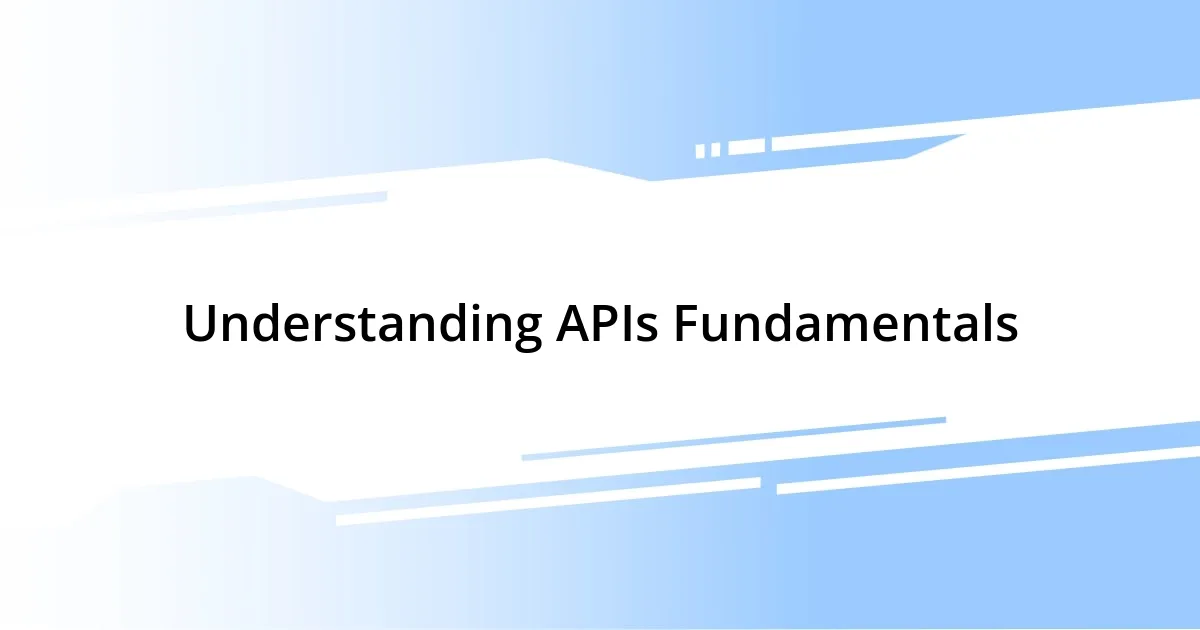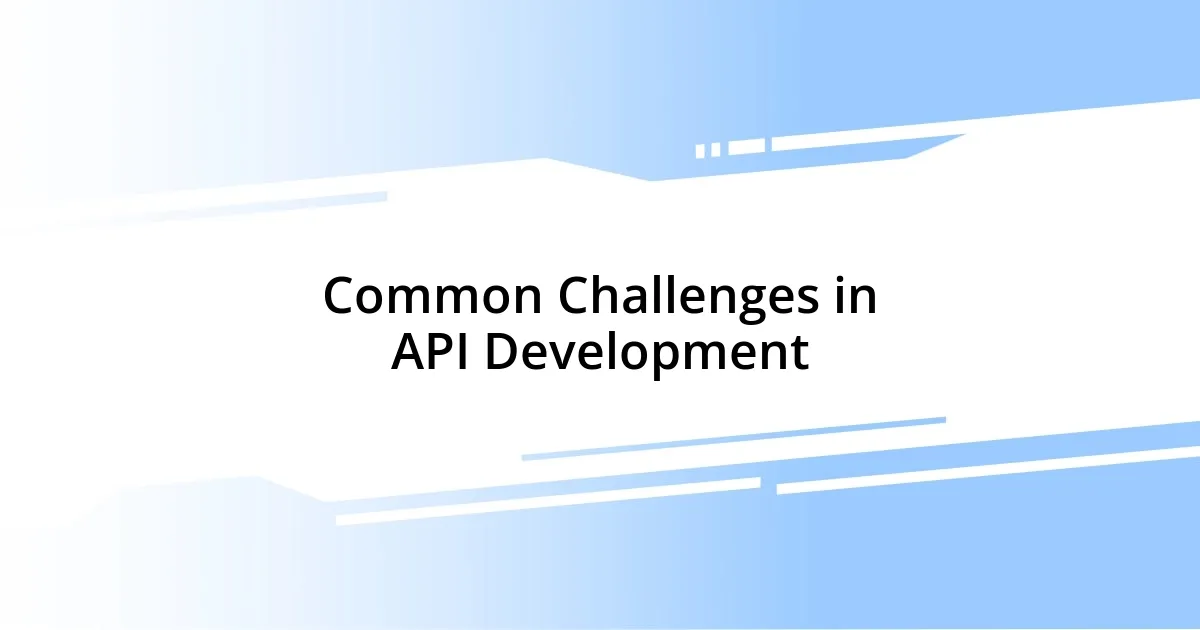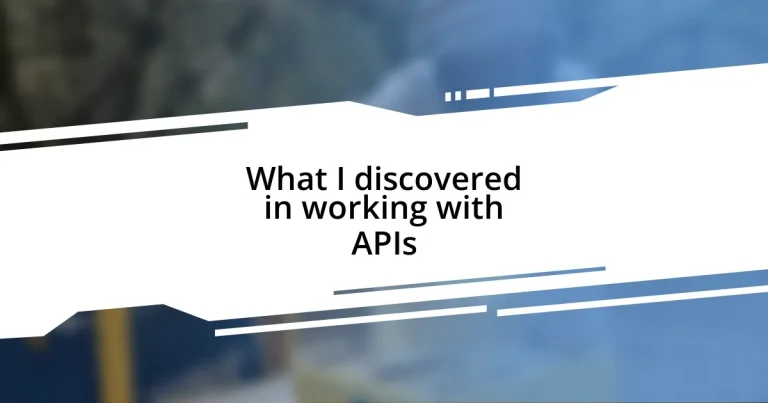Key takeaways:
- APIs act as bridges between applications, using styles like REST for seamless communication and functionality.
- Integration challenges include managing versioning, ensuring performance, and implementing robust security measures.
- Simplicity, consistency in design, and comprehensive documentation are critical for successful API development.
- Emerging trends in APIs feature low-code platforms, heightened security measures, and the rise of GraphQL for data querying.

Understanding APIs Fundamentals
When I first started delving into APIs, it struck me how they serve as bridges between different software applications. Think of an API like a waiter in a restaurant—your request goes to the kitchen, where the server (the API) fetches the dish (the data) you ordered. Isn’t it fascinating how this invisible layer of communication can make complex interactions seamless?
One fundamental aspect of APIs is their ability to operate in different styles, like REST or SOAP. I vividly recall trying to integrate a REST API for the first time; the simplicity of using standard HTTP methods made me appreciate its design. Have you ever used an interface that just clicked? That’s exactly how I felt when I understood that makes REST APIs so intuitive.
As I explored the structure of APIs, I became aware of the importance of documentation. A well-documented API can be a game-changer, guiding you through requests, responses, and error handling. I often find myself getting frustrated with poorly documented APIs, wishing for better instructions. It raises the question: how much easier would our work be if every API had notes that were as clear as a friendly tutorial?

How API Integration Works
Integrating APIs feels a bit like piecing together a puzzle, where each component needs to fit just right. My first experience involved connecting a payment gateway, which was both exciting and daunting. I remember staring at the API documentation, trying to decipher how to authenticate my requests. Once I figured out the right endpoints and headers, I felt a wave of relief wash over me — the connection actually worked!
Understanding the technical mechanics of API integration sheds light on important elements that facilitate smooth communication:
- Endpoints: Think of them as specific URLs where requests are sent.
- HTTP Methods: These include GET, POST, PUT, and DELETE; each serves a different function.
- Authentication: Secure connections often require tokens or API keys to access data.
- Error Codes: Familiarizing yourself with these helps in troubleshooting connection issues.
- Data Format: Most APIs use JSON or XML to structure data exchanges, and knowing these formats is critical.
In my case, when I finally received that “success” response on my first attempt, it was like hitting a home run—I couldn’t help but smile at my accomplishment! Each successful integration feels like unlocking a new tool in my toolkit, ready to tackle the next challenge that comes my way.

Common Challenges in API Development
Developing APIs often uncovers a myriad of challenges that can test your technical prowess and patience. One significant hurdle I encountered was handling versioning. When APIs evolve, updates can break backward compatibility, leading to confusion for users who rely on my API. It’s a real juggling act to balance new features while maintaining the functionality of previous versions. Trust me, the first time I accidentally broke an integration due to an unannounced change, I felt like I was left out in the cold without a coat!
Another common challenge arises from performance issues, particularly regarding response times. I distinctly remember optimizing an API that was running sluggishly. It was disheartening to see users frustrated because they faced delays. I took a deep dive into caching strategies and load balancing, which ultimately improved the speed. Reflecting on that experience, I realized how critical it is to prioritize performance in API development—after all, in our fast-paced world, no one wants to wait!
Lastly, managing security can be daunting in API development. I learned this lesson the hard way when a colleague’s API was compromised due to inadequate authentication. It was a wake-up call for our entire team. Now, I make it a point to implement robust security measures like OAuth and HTTPS, ensuring that user data remains protected. Have you ever faced a security scare that made you rethink your entire approach? I certainly did, and it reshaped how I view API development.
| Challenge | Description |
|---|---|
| Versioning | Managing changes in API versions without breaking existing integrations. |
| Performance | Ensuring quick response times and scalability to handle high traffic. |
| Security | Implementing robust measures to protect user data from breaches. |

Best Practices for API Design
When it comes to API design, simplicity is paramount. I remember spending hours simplifying an API for a client; I wanted it to be user-friendly, yet powerful. After streamlining the documentation and reducing the number of required parameters, the feedback was overwhelmingly positive. Users felt empowered, and I realized that clear, concise design goes a long way in API adoption.
Consistency in naming conventions is another key practice I’ve found essential. In one project, I initially varied naming styles, using both camelCase and snake_case. It led to confusion—developers stumbled and wasted time figuring out how to interact with my API. I soon learned the importance of sticking to one style; it not only helps in maintaining clarity but also fosters a better developer experience. Have you ever faced a similar situation?
Lastly, providing thorough documentation can make or break an API’s success. I once worked on an API where the documentation was sparse at best, and users struggled to implement it. After revising it with examples and use cases, the difference was night and day. Suddenly, users felt like they had a well-lit path guiding them through. It became clear to me: comprehensive documentation isn’t just helpful; it’s an empowering tool that builds trust and confidence in your API.

Real-World API Examples
One real-world example that stands out to me is when I integrated the Twilio API for a messaging application. At first, I was pleasantly surprised by how straightforward it was to send SMS notifications with just a few lines of code. However, when I hit send on my first batch of messages, I was unexpectedly met with a wave of excitement. Seeing users respond almost instantly made me appreciate the power of APIs in enhancing user engagement. Can you recall a time when an integration transformed a user experience dramatically?
On another project, I worked with the Spotify API to create a personalized playlist generator. Diving into the vast array of data it provided was fascinating. However, I quickly learned that working with user preferences could be challenging. It required me to pivot my approach and tailor the algorithms to ensure the playlists felt genuinely curated. Reflecting on that time, I became aware of how critical it is to combine user data with creativity for an enriching experience. If you’ve ever tried to build something unique with data, you know the fine line between personalization and overwhelming users.
I also had the chance to utilize the Google Maps API for a travel app, and it was a game-changer. However, integrating location data into my app initially felt like a daunting task. The complexity of correctly displaying routes and points of interest left me feeling a bit overwhelmed. Yet, once I managed to get it all working smoothly, the thrill of seeing users easily navigate their travels was rewarding. Have you faced a technical challenge that turned into a gratifying outcome? It’s those triumphs that make API work so fulfilling!

Future Trends in API Technology
As I reflect on my journey with APIs, one compelling trend I see is the rise of low-code and no-code platforms. These solutions are democratizing API access, enabling non-developers to build complex applications without deep technical knowledge. I recall a project where I introduced a no-code tool to a team unfamiliar with API integrations, and the excitement was palpable. They felt empowered to experiment and create, transforming their workflow entirely. Isn’t it fascinating how technology can bridge skill gaps?
Another trend is the explosion of API security measures, especially with the increasing concerns around data privacy. I learned the hard way when I overlooked a basic authentication step, and it haunted me for weeks. The growing emphasis on OAuth and token management must not be underestimated. As we navigate this landscape, I constantly remind myself: secure APIs are not just a necessity; they’re a user’s right.
Lastly, I’ve been intrigued by the advancement of GraphQL as an alternative to RESTful APIs. My first experience with GraphQL was eye-opening; its ability to request specific data points dramatically simplified our queries. This agility became a cornerstone in my development process, and I realized how crucial it is for modern applications to adapt to user demands. Have you ever felt the relief of a tool that clicks perfectly with your needs? That’s the potential GraphQL holds for API evolution.














